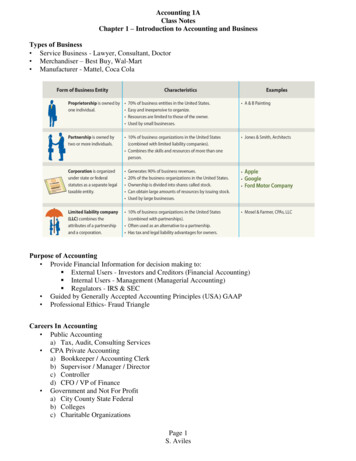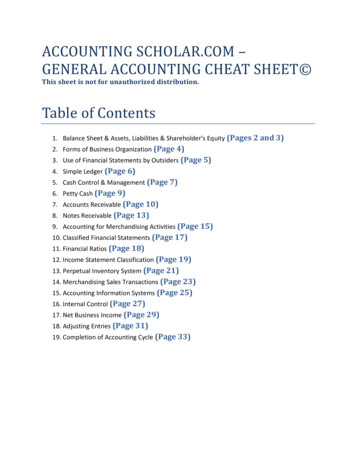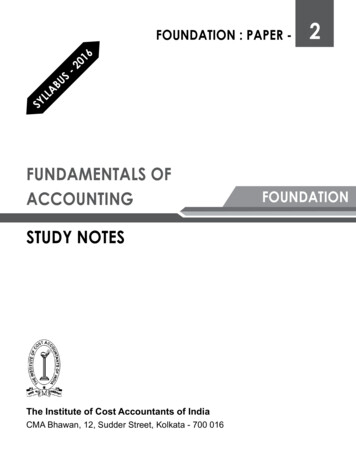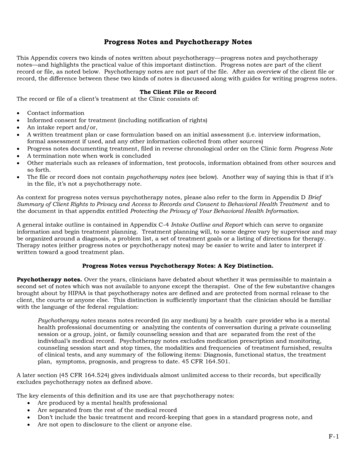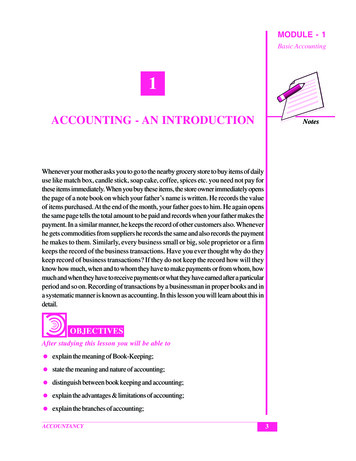
Transcription
MODULE - 1Basic Accounting1ACCOUNTING - AN INTRODUCTIONNotesWhenever your mother asks you to go to the nearby grocery store to buy items of dailyuse like match box, candle stick, soap cake, coffee, spices etc. you need not pay forthese items immediately. When you buy these items, the store owner immediately opensthe page of a note book on which your father’s name is written. He records the valueof items purchased. At the end of the month, your father goes to him. He again opensthe same page tells the total amount to be paid and records when your father makes thepayment. In a similar manner, he keeps the record of other customers also. Wheneverhe gets commodities from suppliers he records the same and also records the paymenthe makes to them. Similarly, every business small or big, sole proprietor or a firmkeeps the record of the business transactions. Have you ever thought why do theykeep record of business transactions? If they do not keep the record how will theyknow how much, when and to whom they have to make payments or from whom, howmuch and when they have to receive payments or what they have earned after a particularperiod and so on. Recording of transactions by a businessman in proper books and ina systematic manner is known as accounting. In this lesson you will learn about this indetail.OBJECTIVESAfter studying this lesson you will be able toexplain the meaning of Book-Keeping;state the meaning and nature of accounting;distinguish between book keeping and accounting;explain the advantages & limitations of accounting;explain the branches of accounting;ACCOUNTANCY3
MODULE - 1Accounting - An IntroductionBasic Accountingstate the functions and objectives of financial accounting;explain accounting as an information system for decision making by the interestedusers andexplain various accounting terms.1.1 BOOK KEEPING AND ACCOUNTINGA business undertakes number of transactions. Can you estimate the number oftransactions a business undertakes? It depends upon the size of a business entity. Everyday business transactions may be around hundreds/thousands. Can a businessmanremember all these transactions in every respect? Not at all. So it becomes necessaryto record these business transactions in details and in a systematic manner. Recordingof business transactions in a systematic manner in the books of account is called bookkeeping. Book-Keeping is concerned with recording of financial data. This may bedefined as.Notes“The art of keeping a permanent record of business transactions isbook-keepng”.From books of accounts important details such as total sales, total purchases, totalcash receipts, total payments, etc. may be ascertained. As you know the main objectiveof business is to earn profits. In order to ascertain the profit earned during a period,mere recording of business transactions is not enough. Accounting involves not onlybook keeping but also many other activities. In 1941, the American Institute of CertifiedPublic Accountants (AICPA) defined accounting as“The art of recording, classifying, summarising, analysing andinterpreting the business transactions systematically and communicatingbusiness results to interested users in accounting”Accounting is identified with a system of recording of business transactions that createeconomic information about business enterprises to facilitate decision making. Thefunction of accounting is to provide quantitative information, primarily financial in nature,about economic entities, that is intended to be useful in making economic decisions.The American Accounting Association defined accounting as :“It is the process of identifying, measuring, recording and communicating therequired information relating to the economic events of an organisation to theinterested users of such information.4ACCOUNTANCY
MODULE - 1Accounting - An IntroductionBasic AccountingIn order to appreciate the nature of accounting it is necessary to understand the followingrelevant aspects of the definition of accounting:zzEconomic events : It is the occurring of the consequence to a business organisationwhich consists of transactions that are measurable in monetary terms. Purchase ofa Machinery, installing and keeping it ready for manufacturing is an economic eventwhich consists of a number of financial transactions. These transactions are (a)buying the machine, (b) transporting the same, (c) preparing the site for its installationand (d) incurring expenditure on installing the same.NotesIdentification, Measurement, Recording and Communication :Identification implies determining what transactions are to be recorded i.e. itemsof financial character are to be recorded. For example, goods purchased for cashor on credit will be recorded. Items of non-financial character such as changes inmanagerial policies, etc. are not recorded in the books of accounts.Measurement means quantification of business transactions into financial termsby using monetary unit. If an event cannot be quantified in monetary terms, it is notconsidered fit for recording in the books of the firm. That is why important itemslike appointment, signing of contracts, etc. are not shown in the books of accounts.Recording : Having identified and measured the economic events in financial terms,these are recorded in the books of accounts in monetary terms date wise. Therecording of the business transactions is done in such a manner that the necessaryfinancial information is summarized according to well established accountingpractices.Communication : The economic events are identified, measured and recorded insuch a manner that the necessary relevant information is generated and communicatedin a certain form to the management and other internal and external users ofinformation. The financial information is regularly communicated through accountingreports.zOrganisation : refers to a business enterprise whether for profit or not for profitmotive.zInterested users of information. Many users need financial information to makeimportant decisions. These users can be investors, creditors, labour unions, TradeAssociations, etc.ACCOUNTANCY5
MODULE - 1Accounting - An IntroductionBasic AccountingEvolution of AccountingAs per Indian mythology Chitra Gupta is responsible for maintaining accountsin God’s court.A book on Arthashasthra written by Kautilya who was a minister in ChandraGupta’s kingdom twenty three centuries ago mentions about the accountingpractices in India. It describes how accounting records have to be maintained.In China and in Egypt accounting was used for maintaining revenue records ofthe government treasury.NotesA book on Arithmetica Geometrica, Proportion at Proportionality(Review of Arithmetic and Geometric proportion) by an Italian Luca Pacioli isconsidered as the first authentic book on double entry book keeping. In hisbook he used the present day popular terms of accounting Debit (Dr.) andCredit (Cr). He also discussed the details of memorandum, journal, ledger andspecialised accounting procedures. He also stated that, “all entries have to bedouble entries, i.e. if you make one creditor you must make some debtor.Accounting process can be summarised asThe AccountingProcessEconomicEventsAccounting links decisionmakers with economicactivities and with the resultsof their n makers(internal andexternal users)Accounting ProcessDifference between book keeping and accounting : Book keeping and accounting canbe differentiated on the basis of nature, objective, function, basis, level of knowledge,etc.6ACCOUNTANCY
MODULE - 1Accounting - An IntroductionBasic AccountingDifference between Book Keeping and AccountingBasis ofDifferenceBook-keepingAccountingNatureIt is concerned with identifying financialtransactions; measuring them in monetaryterms; recording and classifying them.It is concerned with summarizing therecorded transactions, interpretingthem and communicating the results.ObjectiveIt is to maintain systematic records offinancial transactions.It aims at ascertaining businessincome and financial position bymaintaining records of businesstransactions.FunctionIt is to record business transactions. So itsscope is limited.It is the recording, classifying,summarizing, interpreting businesstransactions and communicating theresults. Thus its scope is quite wide.BasisVouchers and other supporting documentsare necessary as evidence to record thebusiness transactions.Book-keeping works as the basis foraccounting information.Level ofKnowledgeIt is enough to have elementaryknowledge of accounting to do bookkeeping.For accounting, advanced and indepth knowledge and understandingis required.RelationBook-keeping is the first step toaccounting.Accounting begins where bookkeeping ends.NotesINTEXT QUESTIONS 1.1I. Fill in the blanks with suitable word/words:i.Keeping systematic record of business transactions is known as .ii. The next step after classification of recorded transactions is .iii. The whole process of recording, classifying, summarizing and interpreting thebusiness transactions systematically and communicating business results to theinterested users of financial information is known as .iv. Interested users of accounting information are .II. Identify transactions related to book-Keeping or accounting and write Bfor book-keeping and A for accounting against the space provided:i.Credit Sales/Purchases(.)ii. Cash Purchases/Sales(.)iii. Calculation of business profits(.)ACCOUNTANCY7
MODULE - 1Accounting - An IntroductionBasic Accountingiv. Find out total debtors(.)v. Find out financial position of the business enterprise(.)1.2 BRANCHES AND OBJECTIVES OF ACCOUNTINGBranches of AccountingThe changing requirements of the business over the centuries have given rise to specializedbranches of accounting and these are :NotesFinancial AccountingIt is concerned with recording the transactions of financial character, summarising andinterpreting them and communicating the results to the users. It ascertains profit earnedor loss incurred during a period (usually one year as accounting year) and the financialposition as on the date when the accounting period ends. It can provide financialinformation required by the management and other parties. The word accounting andfinancial accounting are used interchangeably. At present we are concerned with financialaccounting only.Cost AccountingIt analyses the expenditure so as to ascertain the cost of various products manufacturedby the firm and fix the prices. It also helps in controlling the costs and providing necessarycosting information to management for decision making.Management AccountingIt is concerned with generating information relating to funds, cost and profits etc. Thisenables the management in decision making. Basically, it is meant to assist themanagement in taking rational policy decisions and to evaluate the impact of its decisionsand actions and the performance of various departments.Tax AccountingThis branch of accounting has grown in response to the difficult tax laws such as relatingto income tax, sales tax etc. An accountant is required to be fully aware of various taxlegislations.Social AccountingThis branch of accounting is also known as social reporting or social responsibilityaccounting. It discloses the social benefits created and the costs incurred by theenterprise. Social benefits include such facilities as medical, housing, education, canteen,provident fund and so on while the social costs may include such matters as exploitationof employees, industrial interest, environment pollution, unreasonable terminations, socialevils resulting from setting up industries etc.8ACCOUNTANCY
MODULE - 1Accounting - An IntroductionBasic AccountingObjectives and Functions of Financial AccountingThe main objectives of financial accounting are as under :Finding out Various BalancesSystematic recording of business transactions provides vital information about variousbalances like cash balance, bank balance, etc.Providing Knowledge of TransactionsNotesSystematic maintenance of books provides the details of every transactions.Ascertaining Net Profit or LossSummarisation in form of Profit and Loss Account provides business income over aperiod of time.Depicting Financial PositionBalance sheet is prepared to depict financial position of business means what the businessowns and what it owes to others.Information to All Interested UsersAfter analysis and interpretation, business performance and position are communicatedto the interested users.Fulfilling Legal ObligationsVital accounting information helps in fulfilling legal obligations e.g. sales tax, income taxetc.Functions of AccountingThe function of accounting is to provide quantitative information primarily financial innature about economic entities, which is intended to be useful in making economicdecisions. Financial accounting performs the following major functions:Maintaining SystematicRrecordsBusiness transactions are properly recorded, classified under appropriate accountsand summarized into financial statements.Communicating the financial resultsIt is used to communicate financial information in respect of net profits (or loss), assets,liabilities etc. to the interested parties.Meeting Legal RequirementsThe provisions of various Laws such as Companies Act, 1956 Income Tax and Sales/VAT Tax Acts, require the submission of various statements i.e. Annual accounts, IncomeTax returns, Returns for VAT etc.ACCOUNTANCY9
MODULE - 1Accounting - An IntroductionBasic AccountingFixing responsibilityIt helps in computation of profits of different departments of an enterprise. This facilitatesthe fixing of the responsibility of departmental heads.Decision makingNotesIt provides the users the relevant data to enable them make appropriate decisions inrespect of investment in the capital
costing information to management for decision making. Management Accounting It is concerned with generating information relating to funds, cost and profits etc.

